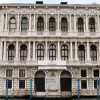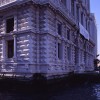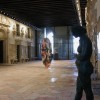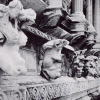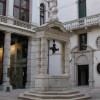The grandiose palace, now seat of the Galleria Nazionale d’Arte Moderna, was built in the second half of the seventeenth century for the noble and wealthy Pesaro family, a project by the greatest Venetian baroque architect, Baldassarre Longhena, who also designed the church of the Salute and Ca’ Rezzonico. Works began in 1659 starting from the landside; the courtyard, with its striking loggias, was completed by 1676; the splendid facade on the Grand Canal had already reached the second floor by 1679, but, on Longhena’s death in 1682, the palace was still unfinished. The Pesaro family entrusted its completion to Gian Antonio Gaspari who concluded it in 1710, in compliance with the original project.
Longhena was inspired by Sansovinian classicism when designing Ca’ Pesaro, elaborating solutions and a language capable of expressing a new and sumptuous harmony, as seen in the Grand Canal façade, with its complex and powerful composition, yet well-balanced: above a plinth decorated with lion-faces and monstrous headsrises a severe diamond-pointed, rusticated façade with two rows of windows, opened in the middle by twin doorways surmounted by mascarons and statues. The Sansovinian motif is more explicit on the first floor, with the insistent chiaroscuro rhythm of the deep-set arches and protruding columns. On the second floor, designed by Antonio Gaspari, the facade is enriched by ornamentation in the pendentives and the entablatures. No less regal is the vast entrance-hall, finely laid out along the axis of the entire building, spacious and well-defined, its half-light contrasting with the luminous clarity of the courtyard, articulated around the monumental well, and enclosed by a terrace and an ashlar-arcade, marked out by doric pilaster-strips, and overlooked by the upper storeys with their architrave-windows.
Sumptuous and imposing, but harmonious and organic in its structure, the palace was constantly enriched, during the long years of its construction, by an equally important process of interior decoration. The palace still conserves some of the fresco and oil decorations of the ceilings, the work of artists such as Bambini, Pittoni, Crosato, Trevisani and Brusaferro; there was also a ceiling by G.B. Tiepolo, with Zephyrus and Flora, which was transferred to the Museum of Ca’ Rezzonico in 1935. But the collections of the Pesaro family, as documented in the archives, must have been even more remarkable, including works by artists such as Vivarini, Carpaccio, Bellini, Giorgione, Titian, Tintoretto, as well as the most famous Venetian artists of the seventeenth and eighteenth centuries. This great heritage had been completely dispersed by 1830, the year of the death of the last Pesaro family member, who auctioned most of the collection in London.
The palace was passed on firstly to the Gradenigo family and then to the Armenian Mechitarist Fathers, who used it as a college. It was finally bought by the Bevilacqua family, and became the property of Duchess Felicita Bevilacqua La Masa. It was her who decreed the present usage of the building, bequeathing it to the city in 1898, as a Museum of Modern Art. In 1902, thanks to the bequest of the Duchess Felicita Bevilacqua La Masa, the Venetian Town Council decided to use the palace to host the municipal collection of Modern Art, which had been started in 1897, when the second Venice Biennale was held. Shortly afterwards, between 1908 and 1924, the ammezzato-storey was used to host the historic Bevilacqua La Masa exhibitions, which, in lively contrast with the Venice Biennale, favored a generation of young artists, including Boccioni, Casorati, Gino Rossi and Arturo Martini.
The collection was enriched over the years by further acquisitions and donations. The former mainly consisted of works bought by the Town Council at the Venice Biennale: up unto the 1950s European Art was favored, in agreement with the Galleria Nazionale d’Arte Moderna of Rome, which generally acquired Italian works at the Biennale. From the 1960s onwards, a new policy was adopted, privileging Italian Art. As a result there was a noticeable increase in the number of works by those artists already mentioned, who, thanks to the Bevilacqua La Masa exhibitions and the polemics that usually surrounded them, made Ca’ Pesaro famous as a driving force for innovation in Italian Art. The collection of works from nineteenth-century Venice is also remarkable. As for the donations, they started with the founding donation by Prince Alberto Giovanelli, followed by Baron Edoardo Franchetti, Baron Ernst Seeger, Filippo Grimani, but above all by Associazione Industriali e Commercianti Veneziani. In 1914 a number of notable works in wax by Medardo Rosso were acquired, and in the 1960s the De Lisi bequest enriched the gallery with works by Morandi, De Chirico, Carrà, Kandinsky, Mirò and Matta, thus filling certain gaps left by the municipal policy of acquisition; finally, in 1990, the gallery received the valuable Wildt donation.
